Basil is an easy-to-grow annual herb, happily grown by garden enthusiasts on kitchen windowsills or in-home vegetable gardens around the world. However, pests that dine on your precious basil leaves can quickly turn your gardening joy into frustration. So if you notice your basil leaves with holes in them, being eaten by uninvited guests, you’re going to want to find the culprits and get rid of them.
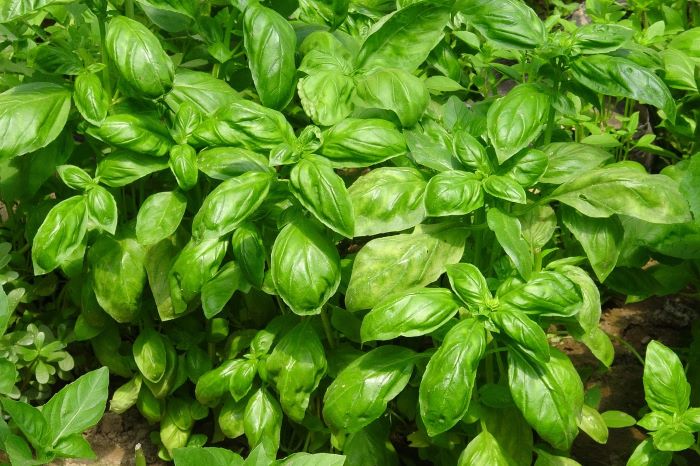
Related: How to Grow Basil | Why Basil Leaves are Yellow | African Blue Basil
Table of Contents
What’s Eating My Basil?
The most likely pests eating your basil are cutworms, aphids, flea beetles, Japanese beetles, grasshoppers, slugs and snails, and leafminers.
Let’s find out more details about each pest and how to fix the problem so those half-chewed basil leaves will be left alone.
1. Cutworms
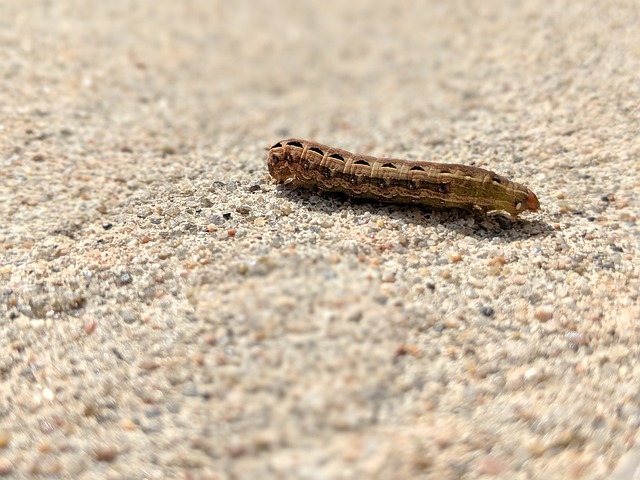
Cutworms are destructive caterpillars that can wreak havoc on your basil plants. These pests belong to the larva stage of various moth species and are known for their habit of cutting young plants at the base, hence their name.
Cutworms vary in color, ranging from brown or black, to pink, depending on the type of moth they are the larvae of. They are smooth caterpillars that will curl into themselves when disturbed and measure 1.5 inches (4 cm).
If cutworms are nibbling on your basil, you will notice your plant’s leaves are starting to wilt, or that it has been cut off at the stem. Certain types of cutworms will climb the stems of your basil plant and make quick work of your plant’s leaves, skeletonizing them within a few nights.
How to Get Rid of Cutworms: If you believe cutworms are munching on your basil leaves, then grab a flashlight and take a stroll in your garden at night. Cutworms are nocturnal, so they feast on your basil plants after dark. If you don’t catch them in the act, disturb the soil around your basil, and you should uncover the C-shaped caterpillars there.
If you spot the smooth caterpillars on your basil plant, simply pluck them off by hand. If there are a lot of cutworms, you can add collars made from tin foil around your basil plants, ensuring it penetrates the ground and a few inches above. Applying a mixture of water and dishwashing liquid can also deter cutworms but my preferred organic method to control cutworms is by using diatomaceous earth around the basil plant.
These pests hide in plant debris during the day, so ensure you keep your garden free from debris to minimize the risk of cutworms. Additionally, you will need to keep your garden free from weeds, as adult moths like to lay their eggs there too.
2. Aphids
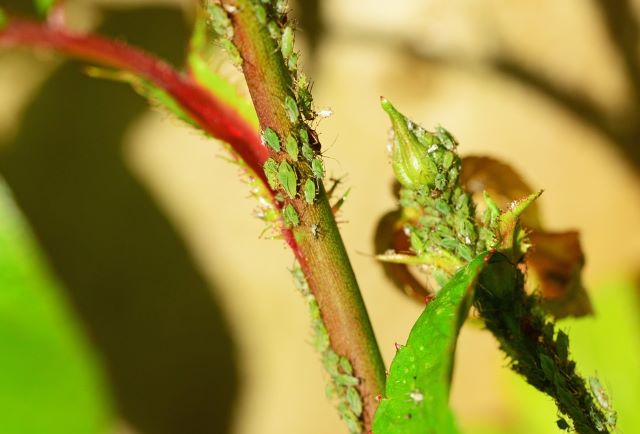
You would be hard-pressed to find a home gardener who has not encountered these soft-bodied little pests. They are an extremely common nuisance in gardens across the world. Aphids are tiny, measuring .01 inches (2-3 mm), and can be green, pink, white, black, or gray.
If aphids are eating your basil, and the infestation is particularly bad, the leaves of your plant will start turning yellow and develop black necrotic spots. Aphids can be found on the underside of your basil’s leaves, or on the stems.
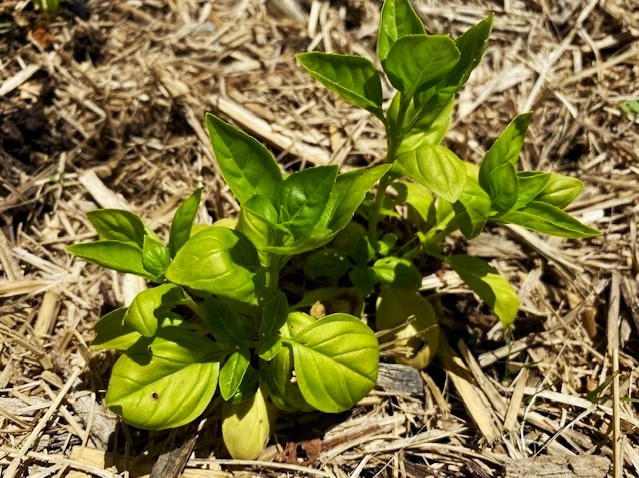
Aphids secrete a sweet sticky substance called honeydew, which attracts ants. So, if you see ants crawling on your basil plant, there is a good chance you have aphids.
How to Get Rid of Aphids: Aphids are one of the easier garden pests to eradicate. To get rid of aphids on your basil plant the first thing you need to do is spray your plant with the garden hose. Spraying them should dislodge them from your plant. However, If any aphids are left behind, simply wipe them away with a damp paper towel.
Next, spray your basil with a mixture of 1 tablespoon of dishwashing liquid mixed into 4 cups (1 lt) of water. You should apply the mixture every 2-3 days for two weeks. You can also use an insecticidal soap spray.
3. Flea Beetles
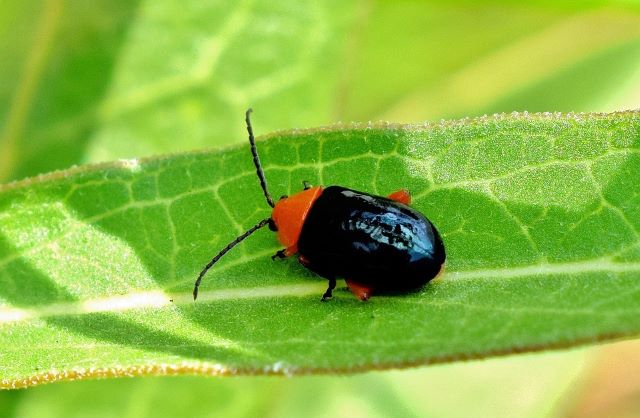
Flea beetles are tiny, hopping insects that can pose a threat to your basil. These pests got their name due to their ability to jump like fleas when startled. Flea beetles are small, measuring between .06-.12 inches (1.5 to 3mm), and can be black, bronze, metallic gray, or bluish.
If flea beetles are eating your basil plant, you will see small, irregular holes, or pits in the leaves of your plant, known as ‘shotholes.’
The damage inflicted on your basil from flea beetles can seriously stunt its growth, cause your basil to wilt, and will eventually kill it.
How to Get Rid of Flea Beetles: If your basil is showing signs of being eaten by flea beetles, an application of neem oil will get rid of them. Another way to deter flea beetles from helping themselves to your basil is to apply a layer of diatomaceous earth around your plants, which will stop them from jumping onto your basil.
You can use floating row covers to protect your basil plants. I’ve found a combination of row covers, and diatomaceous earth to be the most effective, non-toxic way to control flea beetles in my garden.
4. Japanese Beetles
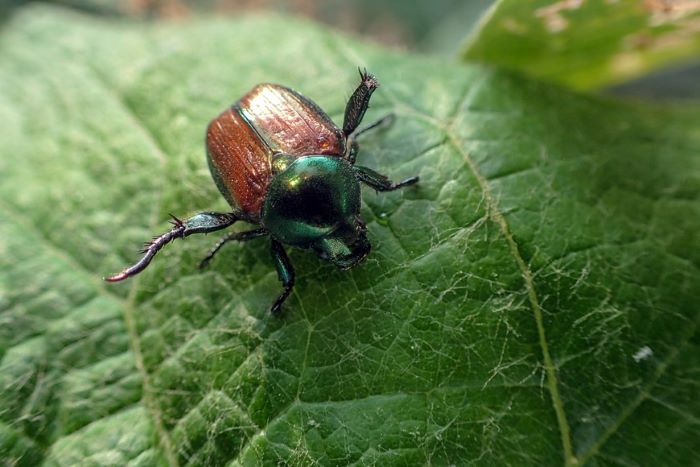
Japanese beetles are a type of scarab beetle that will feast on your basil plant feverishly, quickly skeletonizing your basil plant. They feed on the tissue between the veins of your basil leaves, giving them a distinctive lacy appearance.
Adult Japanese beetles are easy to distinguish, as they are 0.5-0.6 inches (13 mm) in length. They have distinctive metallic-green heads with brown or copper bodies, with white tufts of hair protruding from under their wings.
The larvae of Japanese beetles are not so readily identifiable as they resemble many grubs that can inflict damage on your garden. What makes the larvae different from other grubs is the bristles on their abdomen.
How to Get Rid of Japanese Beetles: To get rid of Japanese beetles on your basil, you will have to start by removing them by hand daily. Japanese beetles release a chemical that calls others to your plants, so removing them daily is vital to control the population.
Next, you can cover your basil with floating row covers to stop the beetles from getting access to your plant. Additionally, you can control a Japanese beetle infestation by spraying your basil weekly with neem oil.
5. Grasshoppers

Grasshoppers can be a frustrating pest in the garden because of the extensive damage they cause. These large insects can quickly devour basil leaves and cause substantial damage if left uncontrolled.
Identifying grasshoppers is fairly easy, as they are medium to large-sized insects known for their long hind legs, which are adapted for jumping. They have chewing mouthparts and typically have wings that allow them to fly. Grasshoppers come in various colors, including green, brown, or a combination of both, camouflaging them in garden vegetation.
If grasshoppers are eating your basil, there will be circular holes at first. The early damage is done by nymphs which are young grasshoppers. As the insect matures, it will make quick work of your basil leaves.
How to Get Rid of Grasshoppers: As grasshoppers are fairly large insects, they are easy to remove by hand. Remove them from your basil as and when you see them. This method is effective when dealing with a smaller infestation, but may not be enough for a larger problem.
Another way to protect your basil from grasshoppers is to cover your plants with floating row covers. This will stop the grasshoppers from landing on your plants.
Additionally, you can apply a homemade garlic oil mixture to your basil to stop grasshoppers from eating your basil.
To make the mixture, add 3 ounces (85 grams) of garlic to 1 f ounce (30 ml) of mineral oil. Allow the garlic to infuse into the oil overnight. Strain the garlic from the oil and then combine it with 2 cups (500mls) of water, and 1 tablespoon of dishwashing liquid. When you want to use the mixture, add two tablespoons to a small spray bottle filled with water.
6. Slugs and Snails
Slugs and snails are common garden nuisances that can cause significant damage to your basil. The feeding habits of these slimy mollusks leave irregular-shaped holes in the leaves and stems of your basil.
Both slugs and snails leave a slimy trail on your plants and the route they took through your garden to reach your basil. A slug is basically a snail without a shell, and both are usually present in gardens.
How to Get Rid of Slugs and Snails: To get rid of slugs and snails you should remove any that you see by hand. Next, to stop them from munching on your basil, spread diatomaceous earth or crushed eggshells around your plants. Or you can use a wildlife and pet-safe bait like this one.
Slugs and snails like moist, shaded areas, such as gardens refuse, so make sure you keep your garden free from debris.
7. Leafminers
Leafminers are a fairly common problem for home gardeners. They are the larvae of leaf miner flies, which lay their eggs on the leaves of your plant. Although they do not kill your plant, they can make the edible leaves on your basil plant, inedible.
Leafminer damage is easy to spot, as they feed within the leaves of your basil, leaving behind a visible trail of thin, white damage. If the infestation is large, white splotches will appear on the leaves of your basil plant.
How to Get Rid of Leafminers: If you see a white winding trail on your basil leaves, you need to remove the infected leaves from your plant. You will need to check your plants for leafminer trails (or mines) regularly to avoid further damage.
Generally, you will not need to intervene in controlling a leafminer problem, other than removing the affected leaves. But, if the problem persists, you can cover your plants with floating row covers (they really are so versatile!) or spray them with neem oil.
Basil Companion Plants to Reduce Pest Attack

You can help keep pests away from your basil plants by planting a diverse garden and including some companion plants. By planting companion plants with your basil, you can confuse and even repel pests!
My favorite companion plants for basil include marigolds, nasturtiums, chives and cilantro. Other effective companion plants include petunias, oregano, rosemary and thyme.
Companion plants work by releasing a strong scent that is repelling to some pests or they can work by attracting beneficial insects that will get rid of unwanted pests for you. For example, ladybugs are attracted to nasturtiums and will feed on aphids.
Keep in mind, companion plants can help you to deter garden pests but you do need to monitor your basil plants regularly for any pest attack. Should you spot a potential pest problem, take action to get rid of them as soon as possible to prevent further plant damage.
I’ve been guilty of saying to myself I’ll take care of the pest problem tomorrow, only to return in a week’s time to a pest infestation! So be sure to stay on top of any unwanted garden visitors and your basil plants will thrive!
